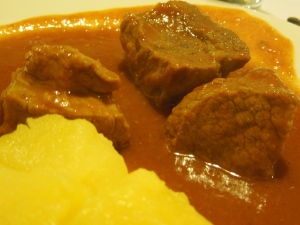 The word goulash sounds so playful, and depending on your life story, it is sure to conjure up a different memory for everyone. I first discovered goulash at its birthplace during a recent trip to Austria and Hungary. A meager offering of three little cubes of beef, the plate generated looks of disbelief from the table, but that sauce was marvelous. Lusty from the butter and prickly from the bursts of paprika, the skillful seasoning of the gravy led me to ask upon first bite, “is this curry?”.
The word goulash sounds so playful, and depending on your life story, it is sure to conjure up a different memory for everyone. I first discovered goulash at its birthplace during a recent trip to Austria and Hungary. A meager offering of three little cubes of beef, the plate generated looks of disbelief from the table, but that sauce was marvelous. Lusty from the butter and prickly from the bursts of paprika, the skillful seasoning of the gravy led me to ask upon first bite, “is this curry?”.
Awkwardly enough, this first encounter was in Vienna, a close three hours,  but not exactly near the center of Budapest. Two days later however, I finally found myself in the
but not exactly near the center of Budapest. Two days later however, I finally found myself in the  Hungarian capital on a dinner cruise. We were treated to a goulash soup. While I appreciated the characteristic burst of paprika, I didn’t necessarily care for all of the excess liquid. I was craving the rich stew that I had back in Vienna. It was interesting to see how much a dish can change from one place to the next.
Hungarian capital on a dinner cruise. We were treated to a goulash soup. While I appreciated the characteristic burst of paprika, I didn’t necessarily care for all of the excess liquid. I was craving the rich stew that I had back in Vienna. It was interesting to see how much a dish can change from one place to the next.
When you come to think of it, goulash actually is one of those dishes that really has morphed itself into many different guises as it traveled around the globe. When I was in Copenhagen, a friend’s host mom served me Danish goulash. Puzzled as I was to first hear about it, it was equally as puzzling to eat it. It certainly was delicious, but it was nothing at all like the Hungarian or Viennese versions I’d had. In its basic essence, it was more related to a classical beef stew, boasting a thick brown gravy brimming with chunks of beef and carrots. To make things super Nordic, the dish was served with boiled mashed potatoes and currant jelly. There was not a speck of paprika to be found, and it actually had me thinking of another beef dish I had in Sweden.
In the States, goulash takes the appearance of being a ground beef and macaroni concoction, frequently found in school cafeterias and generating either strong feelings of love or hate. I have never had this rendition before, and I’m not sure if I ever will because it frankly does not sound that great.
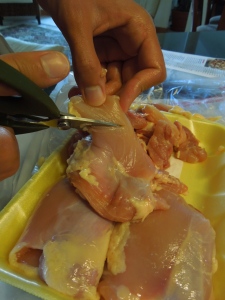 The goulash recipe I share with you today is hardly Hungarian at all, save for the large amounts of hot Hungarian
The goulash recipe I share with you today is hardly Hungarian at all, save for the large amounts of hot Hungarian 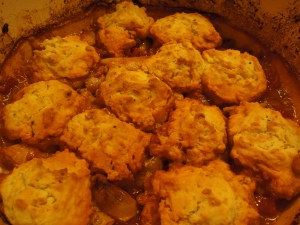 paprika thrown in. It’s made with chicken and features biscuit dumplings floating around on top. Think of it as a spin on a traditional chicken and dumplings pot. It’s a wonderful one-pot meal perfect for any weeknight adventure. The sauce is just as lusty the Viennese variety, while the paprika packs a punch far more powerful than one to be found in the famous Hungarian soup. The best part however, is the biscuits. Wonderfully moist, these tasty morsels soak up the sauce and help to temper down the heat. As I have said before, “good food travels”, and this goulash, while nothing like the original, does show how one powerful spice and one funny sounding word have been able to transform culinary pallets around the world.
paprika thrown in. It’s made with chicken and features biscuit dumplings floating around on top. Think of it as a spin on a traditional chicken and dumplings pot. It’s a wonderful one-pot meal perfect for any weeknight adventure. The sauce is just as lusty the Viennese variety, while the paprika packs a punch far more powerful than one to be found in the famous Hungarian soup. The best part however, is the biscuits. Wonderfully moist, these tasty morsels soak up the sauce and help to temper down the heat. As I have said before, “good food travels”, and this goulash, while nothing like the original, does show how one powerful spice and one funny sounding word have been able to transform culinary pallets around the world.
Egészségedre! (that’s cheers in Hungarian)
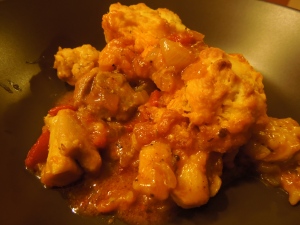 Recipe: Chicken Goulash with Biscuit Dumplings
Recipe: Chicken Goulash with Biscuit Dumplings
Slightly adapted from a recipe found in the March 2013 of Food and Wine
Ingredients
- 2 pounds skinless, boneless chicken thighs, cut into 2-inch pieces
- salt and pepper, to taste
- 1 1/2 cups all-purpose flour
- 5 tablespoons cold unsalted butter, cut into cubes
- 2 tablespoons olive oil
- 2 teaspoons baking powder
- 2 1/2 cups chicken stock
- 1 cup sour cream
- 1 large onion, finely diced
- 1 jarred roasted bell pepper, finely chopped
- 3 garlic cloves, minced
- 2 tablespoons hot Hungarian paprika
- 3/4 teaspoon caraway seeds
- 1 teaspoon fresh thyme leaves
Method
1. Preheat the oven to 425 degrees Fahrenheit. Season the chicken pieces with salt, pepper, and a light dusting of flour. In a large skillet, melt 1 tablespoon of butter in the olive oil and cook the chicken pieces over high heat, turning once until browned on all sides, about seven minutes. Transfer the chicken to a plate, leaving the excess oil behind in the skillet.
flour. In a large skillet, melt 1 tablespoon of butter in the olive oil and cook the chicken pieces over high heat, turning once until browned on all sides, about seven minutes. Transfer the chicken to a plate, leaving the excess oil behind in the skillet.
2. In a food processor or stand mixer, mix together the 1 1/2 cups flour with the baking powder, 1/2 teaspoon of salt, and 1/4 teaspoon of black pepper. Add in the remaining 4 tablespoons of butter and pulse until the mixture resembles a coarse meal and the butter is about the size of peas. Mix in 1/2 cup of the sour cream and 1/2 cup of the chicken stock and incorporate until a dough forms.
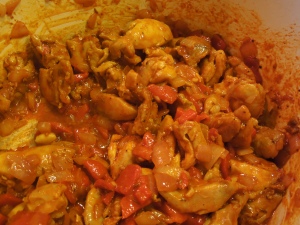 3. Add the onion, bell pepper, and garlic to the skillet and cook over high heat until softened, about 3 minutes. Then return the chicken to the skillet and stir in the paprika and caraway seeds. Cook for an additional 30 seconds. Add the remaining 2 cups chicken stock and 1/2 cup sour cream and stir until smooth. Add the thyme leaves and bring the mixture to a boil.
3. Add the onion, bell pepper, and garlic to the skillet and cook over high heat until softened, about 3 minutes. Then return the chicken to the skillet and stir in the paprika and caraway seeds. Cook for an additional 30 seconds. Add the remaining 2 cups chicken stock and 1/2 cup sour cream and stir until smooth. Add the thyme leaves and bring the mixture to a boil.
4. Scoop twelve, 3 tablespoon-sized mounds of the biscuit dough over the chicken. Transfer the skillet to the oven and bake for about 30 minutes, until the sauce is bubbling and the biscuits have cooked through. Turn on the broiler and broil for about 2 more minutes, until the biscuits are golden. Serve warm in bowls.
chicken. Transfer the skillet to the oven and bake for about 30 minutes, until the sauce is bubbling and the biscuits have cooked through. Turn on the broiler and broil for about 2 more minutes, until the biscuits are golden. Serve warm in bowls.
Cooking Notes:
- This dish is spicy! If you feel like you can’t handle the heat, then you can use a combination of 1 tablespoon hot Hungarian paprika and 1 tablespoon sweet Hungarian paprika.